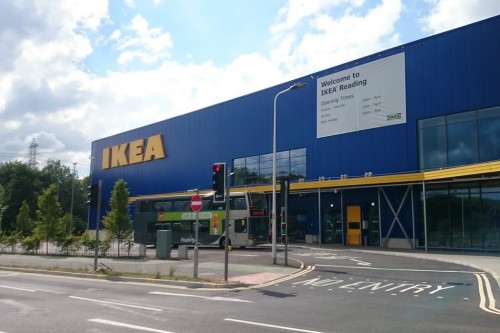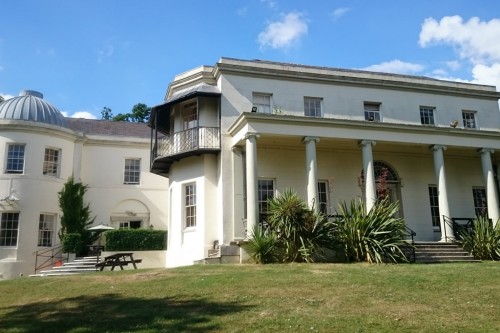West Reading lies west of Reading's commercial centre and includes the suburbs of Tilehurst, Southcote and Coley. Most of this area is in the Reading West parliamentary constituency.
Tilehurst
Tilehurst is situated on a hill to the west of Reading. Much of Tilehurst was enclosed common land during the 18th and 19th centuries; as this land was developed with housing the commons were lost. In the 2001 census there were 14,683 residents in Tilehurst.
Schools
Tilehurst is served by two comprehensve secondary schools - Denefield School and Little Heath School. The catchment areas of Prospect School and Theale Green Community School also cover parts of Tilehurst.
Tilehurst is served by Brookfields School, a special school catering for students with moderate, severe or profound and multiple learning difficulties.
Primary education in Tilehurst includes Birch Copse Primary School, Downsway Primary School, English Martyrs' Catholic Primary School, Moorlands Primary School, Park Lane Primary School, Ranikhet Primary School, St Michael's Primary School, St Paul's Catholic Primary School, Springfield Primary School, Meadow Park Academy, Westwood Farm Infant School, and Westwood Farm Junior School.
Transport
Tilehurst railway station is located at the northern edge of Tilehurst. It has regular rail services between Reading and Oxford on the Great Western Main Line, and commuter services to London Paddington. Reading buses services 15, 16, 17, 28, 33, 101, 104 and 104 serve Tilehurst connecting the village to Reading, Newbury, Purley and Pangbourne.
Nature
Tilehurst has a site of Special Scientific Interest (SSSI) just to the west of the village, called Sulham and Tidmarsh Woods and Meadows.
Tilehurst has four local nature reserves called Blundells Copse, Lousehill Copse, McIlroy Park & Round Copse.
Sport
Tilehurst is represented by three football teams Barton Rovers, Tilehurst Panthers and Westwood Wanderers.
Tilehurst Cricket Club existed from at least 1883.
History
Tilehurst was first recorded in 1291, when it was listed as a hamlet of Reading in Pope Nicholas III's taxation. At this time, the settlement was under the ownership of Reading Abbey where it stayed until the Dissolution of the Monasteries. Tilehurst became an extensive parish, which included the tything of Theale as well as the manors of Tilehurst, Kentwood, Pincents and Beansheaf.
Notable Residents
Kate Winslet, actor grew up in Tilehurst.
Bryan Adams, musician, lived in Tilehurst in the 1960s while his father was stationed in the UK.
Jacqueline Bisset grew up in Tilehurst in a 17th-century country cottage, where she now lives part of the year.
Kenneth Branagh, actor, attended Meadway School in the 1970s.
Mike Oldfield, musician, grew up in Tilehurst.
Ayrton Senna, Formula 1 driver, lived on the Pottery Road estate in the 1980s.
Southcote
Southcote is a suburb of Reading. Located to the south-west of Reading town centre, Southcote has a population of about 8,500 as of 2011. The settlement lies primarily between the London-to-Bath road and the River Kennet.
Shopping
West of Southcote, next to Junction 12 of the M4 is the new Ikea Reading superstore.
Schools
Three primary schools are situated in Southcote: Manor Primary School, Holy Brook Special Educational Needs School, and Southcote Primary School. Three secondary schools are in operation in Southcote. Prospect School, The Blessed Hugh Faringdon Catholic School and The Wren School. Also within the grounds of Prospect School, is the headquarters of the Berkshire Maestros music school.
Nature
Prospect Park, one of the largest open spaces in Reading, is in Southcote Ward which includes a restaurant, playground and a minature railway. Bordering Prospect Park is Devil's Dip, a former gravel and clay pit. The site is recognised by Reading Borough Council as an area of wildlife and historical interest.
Southcote also has Linear Park and Southcote Farm Lane playground. Coronation Square is a designated green space in the centre of Southcote.
History
The name "Southcote", originates from the Old English "suth cote", meaning "south[ern] cottage"
The area was sparsely populated until after the Second World War, though excavations have revealed evidence of Paleolithic and Iron Age activity in Southcote, as well as Roman and Saxon habitation. By the time William the Conqueror undertook the Domesday Survey in 1086, Southcote was sufficiently established to warrant a Lord of the Manor, who at that time was William de Braose. From the 16th century onwards, Southcote Manor was owned by the Blagrave family, who sold the manor house in the 1920s when it was demolished. The area was subsequently developed into housing: much of the land changed from agricultural to residential.
In the 1950s, a huge building project centred around Coronation Square (named for the 1953 Coronation of Queen Elizabeth II) with hundreds of council houses built to satisfy post-war demand. The residents of many of these had moved from houses in central and east Reading.
Notable Residents
The Blagrave family - John Blagarve, mathematician, Daniel Blagrave MP, John Blagrave MP
Derek Watkins, musician
Michael Bond, author and creator of Paddington Bear.
Coley and Coley Park
Coley is a district near the centre of Reading town. It is often referred to as Old Coley, to distinguish it from the adjacent, and much more recent, suburb of Coley Park. Historically the name referred to the area roughly bounded by Castle Street, Castle Hill and the Bath Road to the north (which include conservation areas), Berkeley Avenue to the south and west, and the River Kennet and Bridge Street to the east.
The Berkshire Record Office is located in Coley Avenue near to the junction with Bath Road.
Coley Park is a suburb of the town of Reading.
Coley Park is largely built on the estate of a country house of the same name. The original manor house, known as Vachel House, was built c. 1555 by Thomas Vachell on the banks of the Holy Brook rivulet (located where Coley Park Farm remains today).
Eventually Vachel House fell into disrepair and a new mansion, Coley House, was built on higher ground by the new owner, John McConnell in 1802.
Between 1882-9, Reading Football Club played their games at Coley Park, on the site now known as Coley Park Recreation Ground.
Take a look at our other Area Guides
Sources:
Wikipedia https://en.wikipedia.org/wiki/West_Reading,_Berkshire
Wikipedia https://en.wikipedia.org/wiki/Tilehurst
Wikipedia https://en.wikipedia.org/wiki/Coley,_Berkshire
Wikipedia https://en.wikipedia.org/wiki/Coley_Park
Ikea http://www.ikea.com/gb/en/store/reading/
Berkshire Record Office http://www.berkshirerecordoffice.org.uk/



